Major Trends in Ageing Population Research: A Bibliometric Analysis from 2001 to 2021 †
Abstract
:1. Introduction
2. Methodology
3. Results and Discussion
3.1. Document Profiles
3.2. Research Trend Analysis
3.3. Geographical Distribution of Publications Analysis
3.4. Authorships and Affiliations Analysis
3.5. Source Title Analysis
3.6. Citation Analysis
3.7. Keywords Analysis
4. Conclusions
Author Contributions
Funding
Institutional Review Board Statement
Informed Consent Statement
Data Availability Statement
Acknowledgments
Conflicts of Interest
References
- Hooyman, N.; Kiyak, H.A. Aging in other countries and across cultures in the United States. In Social Gerontology: A Multidisciplinary Perspective, 9th ed.; Pearson: London, UK, 2011; pp. 43–68. [Google Scholar]
- Miller, S. Get ready-the age-quake is heading our way. Need for major changes seen to care for aging population. The Baltimore Sun, 5 December 1991. [Google Scholar]
- United Nations, Department of Economic and Social Affairs, Population Division. World Population Ageing 2015; United Nations: New York, NY, USA, 2015; ST/ESA/SER.A/390. [Google Scholar]
- Dobriansky, P.J.; Suzman, R.M.; Hodes, R.J. Why Population Aging Matters—A Global Perspective; Department of State: Cambridge, UK, 2007. [Google Scholar]
- Kochhar, R.; Oates, R. Attitudes about Aging: A Global Perspective; Pew Research Center: Washington, DC, USA, 2014. [Google Scholar]
- Moher, D.; Liberati, A.; Tetzlaff, J.; Altman, D.G. Preferred reporting items for systematic reviews and meta-analyses: The PRISMA statement. BMJ 2009, 339, 332–336. [Google Scholar] [CrossRef] [PubMed]
- Zakaria, R.; Ahmi, A.; Ahmad, A.H.; Othman, Z. Worldwide melatonin research: A bibliometric analysis of the published literature between 2015 and 2019. Chronobiol. Int. 2021, 38, 27–37. [Google Scholar] [CrossRef] [PubMed]
- Ahmi, A.; Mohamad, R. Bibliometric Analysis of Global Scientific Literature on Web Accessibility. Int. J. Recent Technol. Eng. 2019, 7, 250–258. [Google Scholar] [CrossRef]
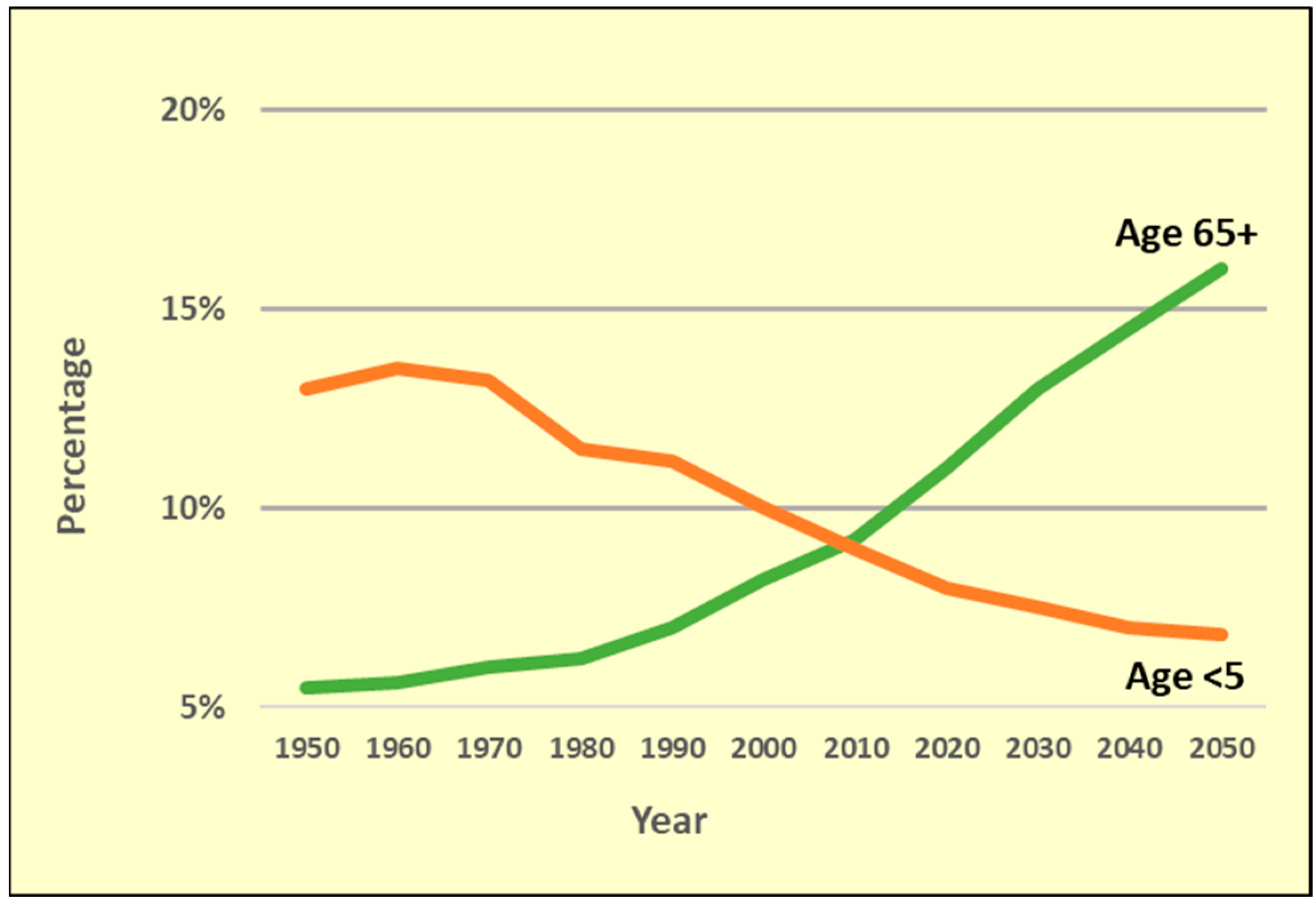

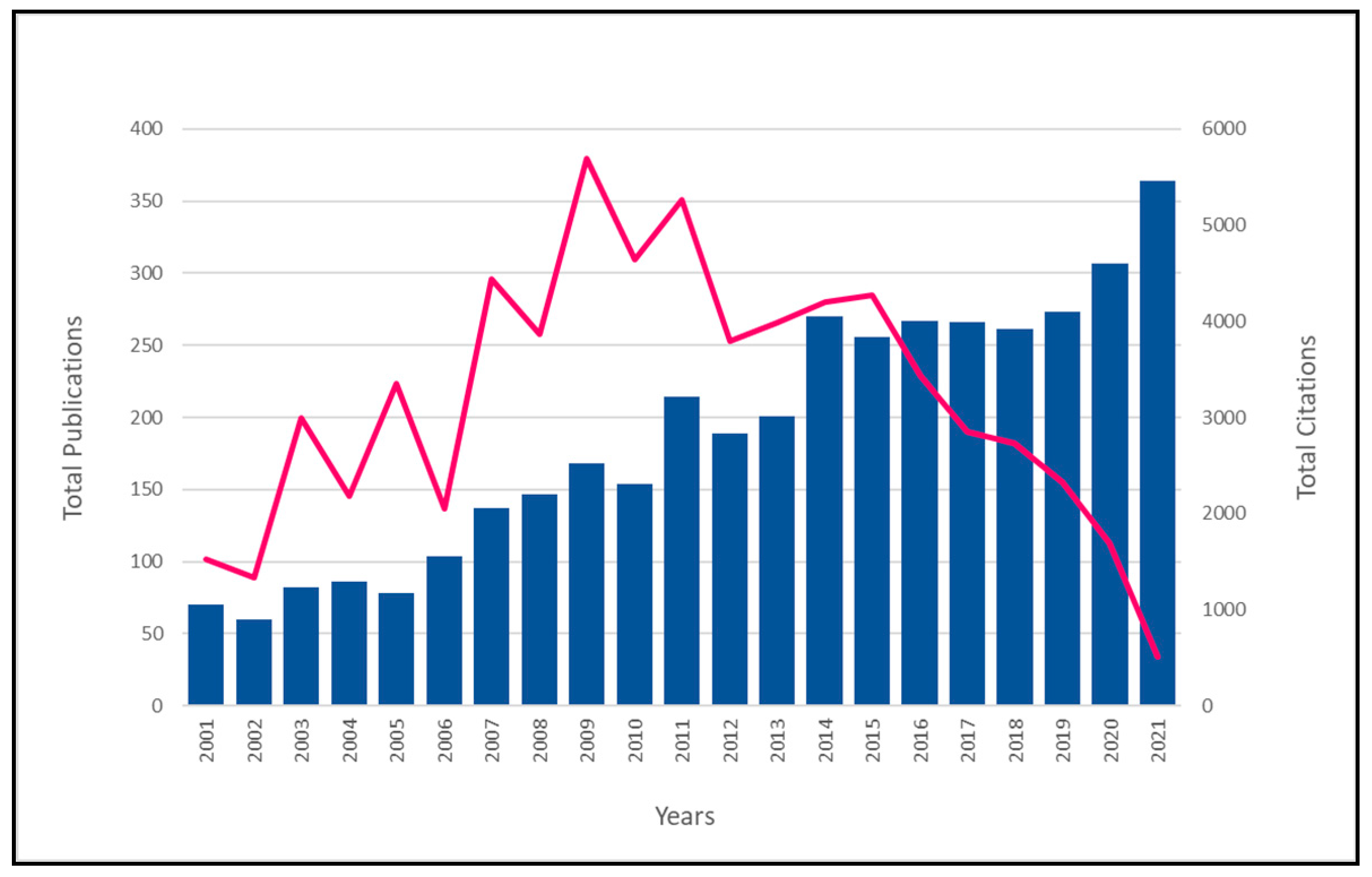
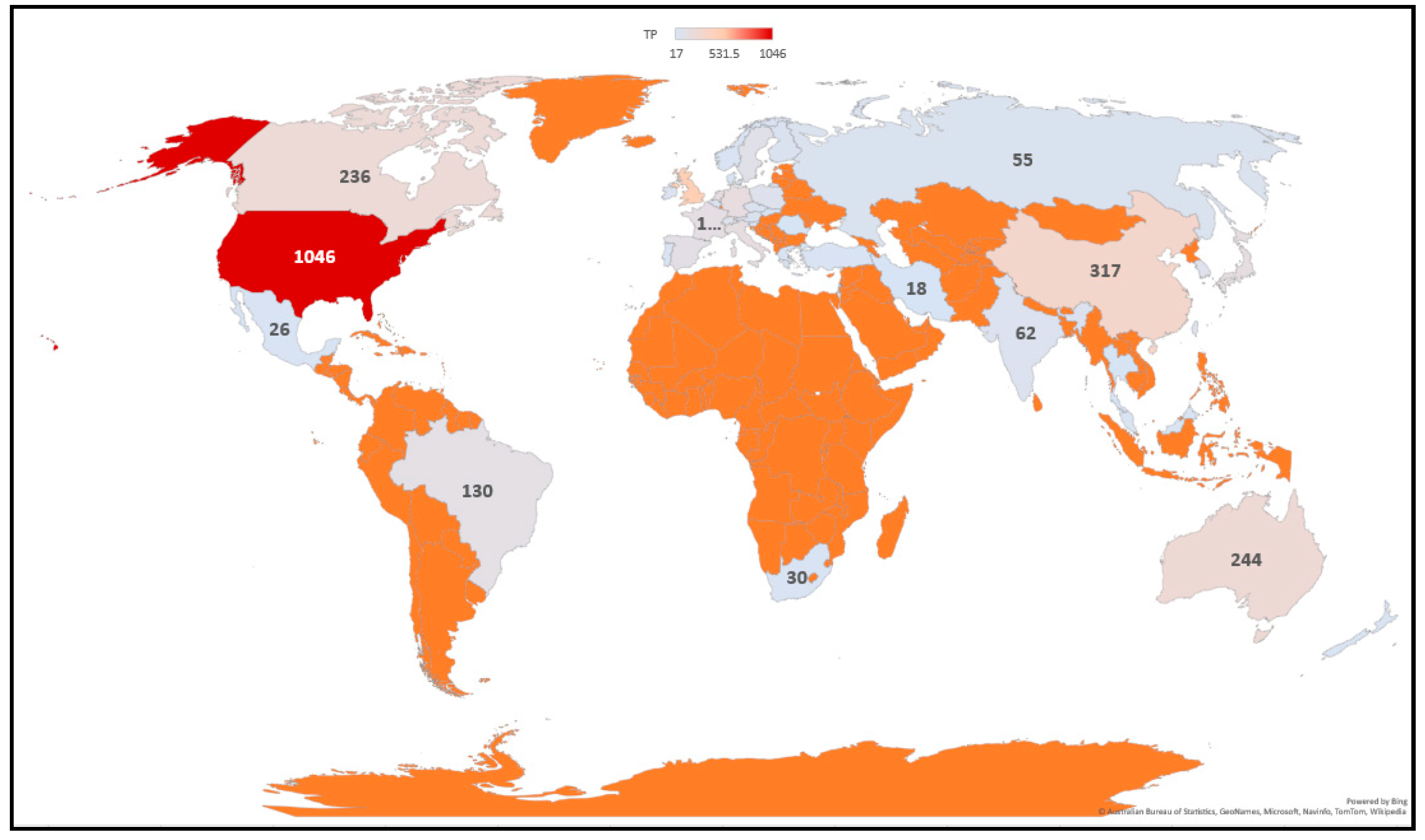
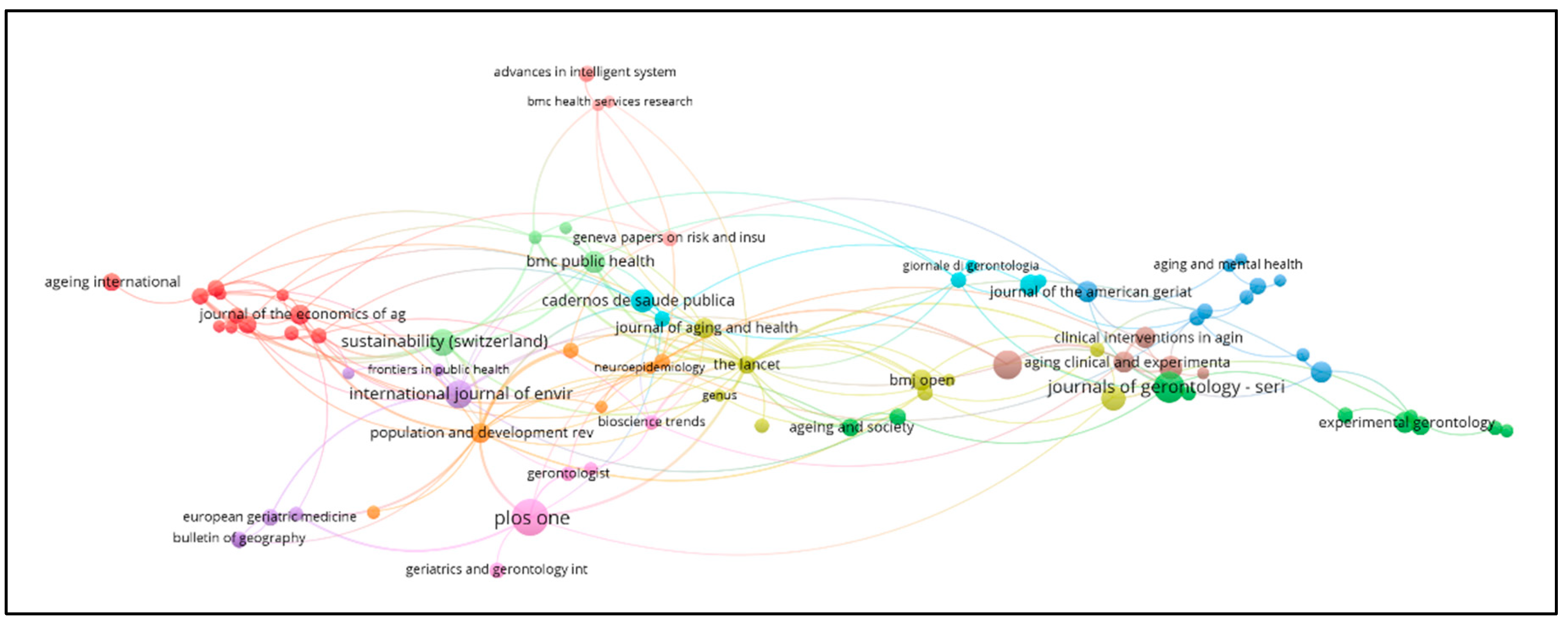
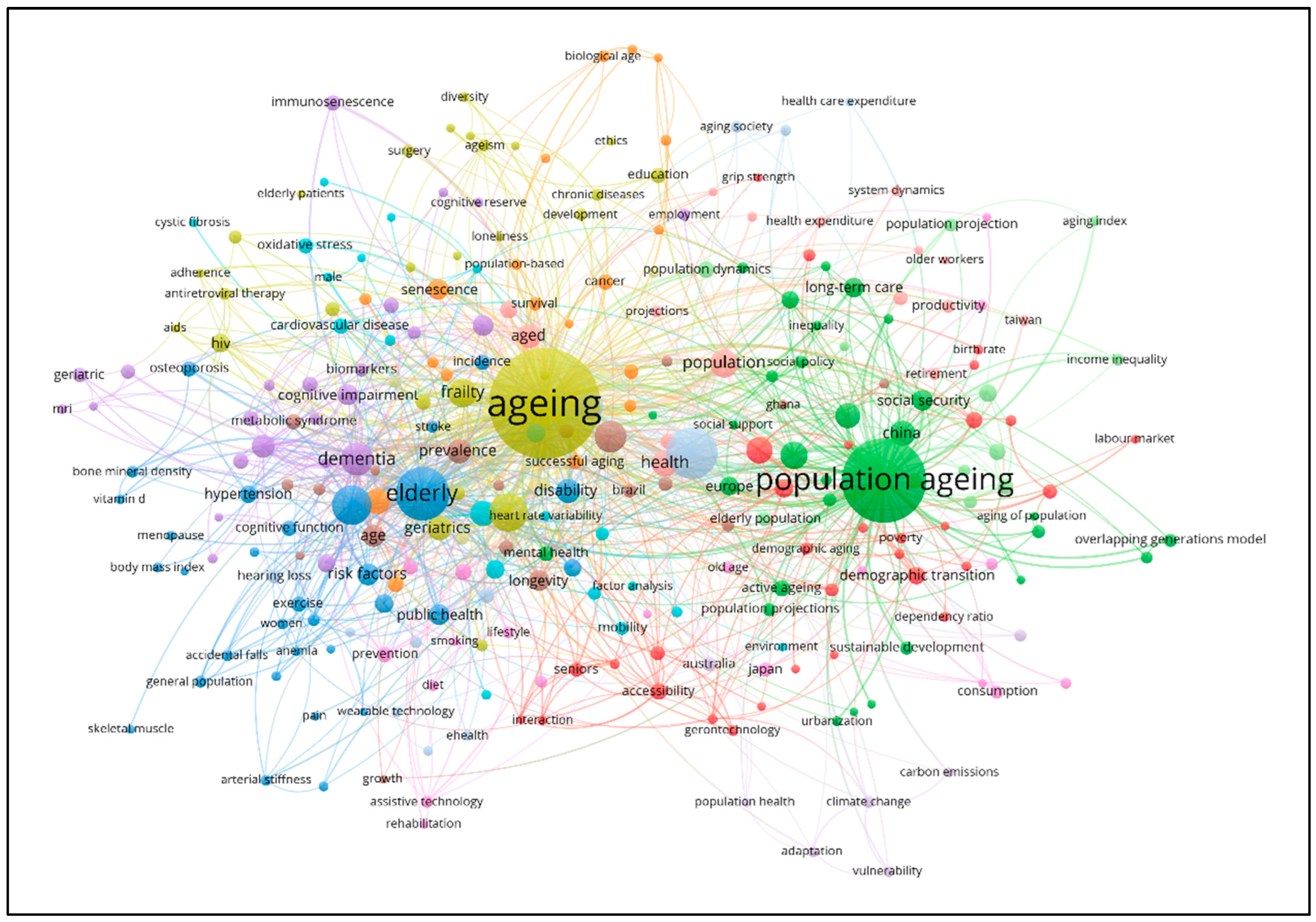
| Document Type | Total Publications (TP) | Percentage (%) |
|---|---|---|
| Article | 2543 | 64.31 |
| Review | 354 | 8.95 |
| Book Chapter | 302 | 7.64 |
| Conference Paper | 259 | 6.55 |
| Editorial | 181 | 4.58 |
| Note | 118 | 2.98 |
| Letter | 56 | 1.42 |
| Book | 51 | 1.29 |
| Erratum | 50 | 1.26 |
| Short Survey | 40 | 1.01 |
| Total | 3954 | 100.00 |
| Subject Area | Total Publications (TP) | Percentage (%) |
|---|---|---|
| Medicine | 2011 | 50.86 |
| Social Sciences | 1012 | 25.59 |
| Biochemistry, Genetics, and Molecular Biology | 454 | 11.48 |
| Economics, Econometrics, and Finance | 386 | 9.76 |
| Nursing | 350 | 8.85 |
| Engineering | 214 | 5.41 |
| Psychology | 186 | 4.70 |
| Environmental Science | 181 | 4.58 |
| Business, Management and Accounting | 178 | 4.50 |
| Computer Science | 170 | 4.30 |
| Affiliation | TP | NCP | TC | C/P | C/CP | h | g |
|---|---|---|---|---|---|---|---|
| University of Alberta | 48 | 31 | 317 | 6.60 | 19.00 | 10 | 16 |
| University College London | 42 | 38 | 1477 | 35.17 | 21.00 | 19 | 38 |
| King’s College London | 38 | 34 | 1564 | 41.16 | 20.00 | 17 | 38 |
| University of Cambridge | 35 | 34 | 2149 | 61.40 | 19.00 | 18 | 35 |
| Inserm | 33 | 30 | 1156 | 35.03 | 19.00 | 17 | 33 |
| Fudan University | 33 | 31 | 361 | 10.94 | 17.00 | 12 | 17 |
| National Institute on Aging | 33 | 30 | 1845 | 55.91 | 21.00 | 18 | 33 |
| Pontifícia Universidade Católica do Paraná | 33 | 22 | 167 | 5.06 | 9.00 | 8 | 12 |
| Lunds Universitet | 33 | 31 | 831 | 25.18 | 18.00 | 15 | 28 |
| Karolinska Institutet | 30 | 27 | 892 | 29.73 | 18.00 | 13 | 29 |
| Author’s Name | TP | NCP | TC | C/P | C/CP | h | g |
|---|---|---|---|---|---|---|---|
| Tonelli, M. | 36 | 24 | 169 | 4.69 | 7.04 | 8 | 12 |
| Riella, M. | 32 | 20 | 124 | 3.88 | 6.20 | 6 | 10 |
| Lima-Costa, M.F. | 22 | 21 | 383 | 17.41 | 18.24 | 11 | 19 |
| Brayne, C. | 18 | 17 | 1122 | 62.33 | 66.00 | 12 | 18 |
| Elmståhl, S. | 16 | 14 | 465 | 27.35 | 33.21 | 7 | 17 |
| Firmo, J.O.A. | 15 | 16 | 644 | 40.25 | 40.25 | 13 | 16 |
| Mason, A. | 15 | 13 | 243 | 16.20 | 18.69 | 10 | 15 |
| Scherbov, S. | 13 | 13 | 1151 | 88.54 | 88.54 | 8 | 13 |
| Guest, R. | 11 | 10 | 52 | 4.73 | 5.20 | 5 | 6 |
| Lee, S.H. | 10 | 9 | 114 | 11.40 | 12.67 | 3 | 10 |
| Source Title | TP | TC | Cite Score | SJR 2020 | SNIP 2020 |
|---|---|---|---|---|---|
| PLOS One | 45 | 877 | 5.3 | 0.99 | 1.349 |
| Journals of Gerontology—Series A Biological Sciences and Medical Sciences | 32 | 934 | 9.1 | 2.134 | 1.771 |
| Archives of Gerontology and Geriatrics | 29 | 499 | 4.3 | 0.985 | 1.361 |
| International Journal of Environmental Research and Public Health | 27 | 277 | 3.4 | 0.747 | 1.356 |
| Lecture Notes in Computer Science (Including Subseries Lecture Notes in Artificial Intelligence and Lecture Notes in Bioinformatics) | 26 | 112 | 1.8 | 0.249 | 0.628 |
| Sustainability Switzerland | 25 | 151 | 3.9 | 0.612 | 1.242 |
| Age and Ageing | 20 | 999 | 9.6 | 2.014 | 2.753 |
| Population Ageing in Central and Eastern Europe Societal and Policy Implications | 20 | 40 | N/A | N/A | N/A |
| Cadernos De Saude Publica | 19 | 203 | 2.3 | 0.633 | 1.267 |
| BMC Geriatrics | 18 | 289 | 4.5 | 1.414 | 1.758 |
| Metrics | Data |
|---|---|
| Papers | 3954 |
| Citations | 67,140 |
| Years | 20 |
| Cites_Year | 3197.14 |
| Cites_Paper | 16.98 |
| Cites_Author | 23,670.96 |
| Papers_Author | 1865.4 |
| Authors_Paper | 3.44 |
| h_index | 105 |
| g_index | 170 |
| Authors | Title | Cites | Cites per Year |
|---|---|---|---|
| Christensen, Doblhammer, Rau, and Vaupel (2009) | Ageing populations: the challenges ahead | 2207 | 169.77 |
| Lutz, Sanderson, and Scherbov (2008) | The coming acceleration of global population ageing | 847 | 60.5 |
| Etzioni, Liu, Maggard, and Ko (2003) | The Aging Population and Its Impact on the Surgery Workforce | 578 | 30.42 |
| Singh and Newman (2011) | Inflammatory markers in population studies of aging | 518 | 47.09 |
| Aw, Silva, and Palmer (2007) | Immunosenescence: Emerging challenges for an ageing population | 511 | 34.07 |
| Bell, Tsai, Yang, Pidsley, Nisbet, Glass, Mangino, Zhai, Zhang, Valdes, Shin, Dempster, Murray, Grundberg, Hedman, Nica, Small, Dermitzakis, McCarthy, Mill, Spector, and Deloukas (2012) | Epigenome-wide scans identify differentially methylated regions for age and age-related phenotypes in a healthy ageing population | 483 | 48.3 |
| Smit, Brinkman, Geerlings, Smit, Thyagarajan, van Sighem, de Wolf, and Hallett (2015) | Future challenges for clinical care of an ageing population infected with HIV: A modelling study | 417 | 59.57 |
| Fox, Richardson, Maidment, Savva, Matthews, Smithard, Coulton, Katona, Boustani, and Brayne (2011) | Anticholinergic medication use and cognitive impairment in the older population: The medical research council cognitive function and ageing study | 408 | 37.09 |
| Pollack (2005) | Intelligent technology for an aging population: The use of AI to assist elders with cognitive impairment | 391 | 23 |
| Fried, Carlson, Freedman, Frick, Glass, Hill, McGill, Rebok, Seeman, Tielsch, Wasik, and Zeger (2004) | A Social Model for Health Promotion for an Aging Population: Initial Evidence on the Experience Corps Model | 369 | 20.5 |
Publisher’s Note: MDPI stays neutral with regard to jurisdictional claims in published maps and institutional affiliations. |
© 2022 by the authors. Licensee MDPI, Basel, Switzerland. This article is an open access article distributed under the terms and conditions of the Creative Commons Attribution (CC BY) license (https://creativecommons.org/licenses/by/4.0/).
Share and Cite
Sabri, S.M.; Annuar, N.; Rahman, N.L.A.; Musairah, S.K.; Mutalib, H.A.; Subagja, I.K. Major Trends in Ageing Population Research: A Bibliometric Analysis from 2001 to 2021. Proceedings 2022, 82, 19. https://doi.org/10.3390/proceedings2022082019
Sabri SM, Annuar N, Rahman NLA, Musairah SK, Mutalib HA, Subagja IK. Major Trends in Ageing Population Research: A Bibliometric Analysis from 2001 to 2021. Proceedings. 2022; 82(1):19. https://doi.org/10.3390/proceedings2022082019
Chicago/Turabian StyleSabri, Sabiroh Md, Nursyamilah Annuar, Nurul Labanihuda Abdull Rahman, Sharifah Khairol Musairah, Hasyeilla Abd Mutalib, and Iwan Kurniawan Subagja. 2022. "Major Trends in Ageing Population Research: A Bibliometric Analysis from 2001 to 2021" Proceedings 82, no. 1: 19. https://doi.org/10.3390/proceedings2022082019
APA StyleSabri, S. M., Annuar, N., Rahman, N. L. A., Musairah, S. K., Mutalib, H. A., & Subagja, I. K. (2022). Major Trends in Ageing Population Research: A Bibliometric Analysis from 2001 to 2021. Proceedings, 82(1), 19. https://doi.org/10.3390/proceedings2022082019






